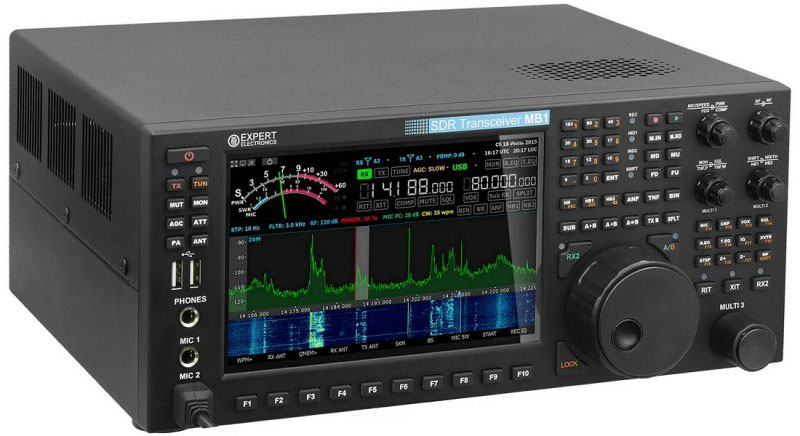


MB1 High End HF, 6m - 2m SDR Transceiver
Description
Many radio amateurs use PC with classical transceiver. In one case it is a notebook, in other – desktop computer. A connection between those two devices every user solves according to its own preference. Perfect solution is MB1
The MB1 transceiver - is a new trend in amateur radio, a transceiver and a PC in a single package. It combines a classic design, developed over several decades, with the most advanced DUC/DDC SDR-technologies Direct Digital Conversion (DDC) and Digital Up Conversion (DUC), plus a fully-featured high-end personal computer with an Intel Core i5 processor on board. The workstation is switched on with one button.
Two independent receive channels with a bandwidth of 312 kHz
Broadband overview of up to 80 MHz
High-quality IPS 7" touchscreen display with a resolution of 1280x800 pixels
ExpertSDR2 software in two versions: for Desktop and for integrated GUI display
Opportunity to install any other software (applicable for Windows 10 OS) by the User
Record and play on air fragments (IQ files) with a bandwidth of up to 312 kHz
Features of the transceiver
An Independent receive path with Digital Direct Conversion (DDC)
A Separate independent transmission path, constructed on the basis of Digital Up Conversion (DUC)
Full duplex or half duplex modes
Two independent receivers with panoramic bandwidths up to 312 kHz plus two sub-receivers
4 HF antenna connectors and 2 VHF
Four separate programmable PTT outputs for external power amplifiers
ALC connector for external power amplifiers
The ability to connect VHF transverters
The ability to use the transceiver as a frequency measuring receiver
The ability to use the transceiver as a signal generator (DAC OUT)
Minor delay in CW mode (about 10 ms)
Ability to use the transceiver in SO2R mode
Remote control mode
Full duplex mode is supported by the transceiver's hardware but is not implemented in the ExpertSDR2 software. It will be supported in the future ExpertSDR2 software releases.
ALC functionality is supported by the transceiver's hardware but is not implemented in the ExpertSDR2 software. It will be supported in the future ExpertSDR2 software releases.
PC capabilities of your transceiver
Installation of digital modes software
Installation of HAM and Contest logs
Two CW Skimmers may be used on different bands
The transceiver can connect to the LAN and the Internet
Use of Internet applications (e.g. e-mail, Skype, ICQ, TV, etc.)
Play video and audio files
Ability to connect two external monitors, keyboard, mouse
Application area
Full-function radio amateur transceiver
Mobile contest-station
Remote receipt point for the contests and other applications
Spectrum analyzer with the bandwidth of up to 80MHz
Operation with the 3rd party programs for digital modes, CW Skimmer, etc.
Software
Special version of ExpertSDR2 software with adapted GUI for 7" display was developed for the MB1 transceiver. At the present time software works in RX/TX mode and supports two independent receiving channels with the bandwidth up to 312 kHz. A DSP library developed by Expert Electronics allow improved receive quality and higher stability of the software.
MB1 supplied accessories
The transceiver includes Automatic Tuner Unit (ATU) for impedance matching antennas with 50 Ohm output path of the transceiver.
Configuration:
MB1 transceiver+ATU
PTT-microphone MD15
Power Supply Cable to connect the transceiver to an AC mains network
Backup fuse 5A
Additional available accessories:
PTT footswitch
E-Coder panel or E-Coder mini kit for convenient remote work
Specifications:
Receiver
Design concept of the receive path
Direct Digital Conversion
RF ADC clock frequency, MHz
160
RF ADC resolution, bit
16
RX frequency range, MHz
0.09 ... 65; 95 ... 148
The maximum width of the spectrum display, MHz
80
Amount of independent RX channels
2
Blocking Dynamic Range (BDR), dB
130
Dynamic Range over IMD3, dB
100
Reciprocal Mixing Dynamic Range (2 kHz), dB
110
MDS level, dBm
-124
Image channel rejection, dB
110
Local oscillator stability, ppm
+/- 0.5
Built-in preamplifier, dB
-20, -10, 0, +10
Additional VHF preamplifier, dB
+22